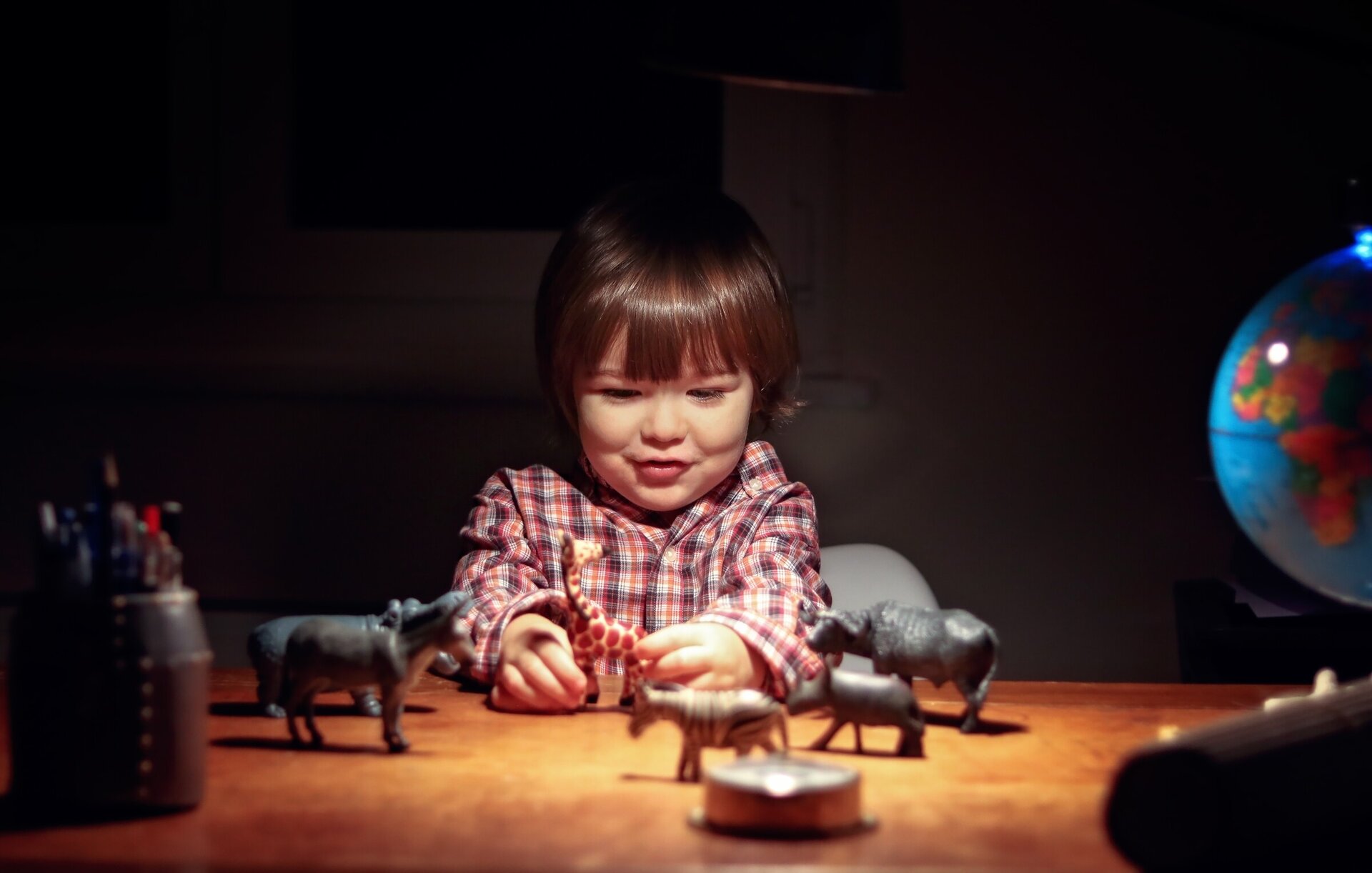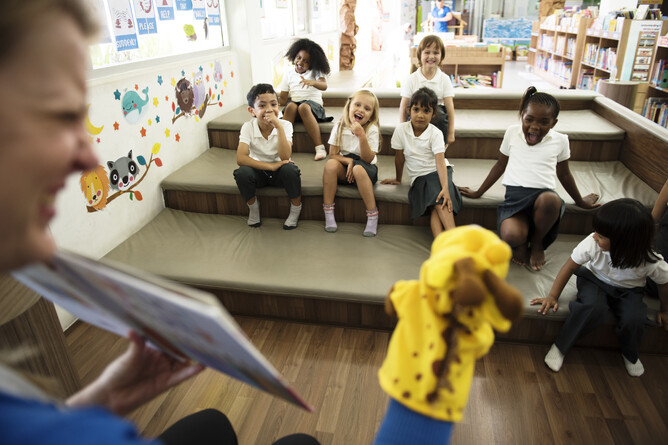Reflecting on a lifetime of puppetry experiences and the overwhelming connection this has with early childhood literacy, New Zealand children’s author and puppet creator, Erin Devlin shares some insights into the power of puppets, props and picture books in early childhood environments.
Erin begins with an account of a recent visit to an early childhood centre where she was invited to share her puppets, stories, songs and rhymes…
Tamariki gather around excitedly as the ‘Puppet Lady’ arrives at Olive Shoots Early Childhood Centre in Henderson, Auckland. They look on curiously as Erin Devlin opens the first of her large suitcases and begins to arrange her performance area with trees and ferns; the idea being to imitate a NZ bush scene. The empty trees soon begin to fill as she places her puppets amongst the branches. First there’s Ruru Morepork, then a Tui sits beside a large impressive Kereru… “Look!” a little girl exclaims, “there’s a baby bird in a nest” as she and her friends watch Erin placing a young Kereru close to its parent. The children are in awe watching the development of these creative props and puppets coming to life. They comment about ‘lots of possums’ as they observe how many are being placed in and around the tree… “Yes, that’s true” Erin nods “There are far more possums than birds in the bush.” She then completes the scene with two kiwi chicks and places yet another nest in the tree ~ this time with a single egg inside as a possum perched close by appears to be watching. The placement of this is not lost on the children who are quick to comment while some voice their knowledge of the bush and its inhabitants, while asking the names of the birds and letting Erin know that “Possums eat the trees and the leaves”. Erin agrees then announces the puppet show is about to commence.
Some ‘hands-on’ hints for teachers using puppets with books:
- To feel confident when embarking on a puppet/story experience be sure you’re familiar and actually enjoy the story you’ve chosen.
- Anyone who has tried to read a story while juggling with several puppets knows how ineffective this can be. A good option is to hold the book up, introduce the story and explain to the children that after they’ve heard you read it you’re going to ask some of them if they’d like to enact the story with puppets. When this happens you can lead the children by reading or repeating the story (they’ll need some prompting from you) as they act out their parts. The ‘actors’ and the ‘audience’ love these fun, learning and interactive experiences!
- Another option is for you to use the puppet(s) but have a colleague turning the pages of the book as you read from it. If there are say 3 characters then you can be the main puppet character and two children can play the part of the lesser characters in subsequent readings and/or play acting. Regular ‘telling’ of the same stories will not only increase your confidence but will develop the storytelling aspect of it for you ~ and if it’s a story you love your enthusiasm will shine through.
- Children are quick to notice by your body language if you’re enjoying telling a story or not.
- If you’re shy using puppets, remind yourself that the puppet is the performer and the children are NOT looking at YOU! In fact the really good news is they’ve probably forgotten you’re even there, they’ll be so preoccupied watching, listening and anticipating what the puppet(s) are going to do next! The secret is, relax, enjoy and learn as you go!
- Practising some puppet skills while looking in a mirror is a great idea. You’ll surprise yourself with how quickly you learn new skills and gain confidence with these practical exercises.
- Concentrate on maintaining eye contact with the puppet. It’s important to do this as it makes the puppet ‘real’ for your tamariki.
- Manipulate the puppet by using slow, tiny movements. Remember, the more subtle the movements, the more realistic the puppet will appear to your young audience.
- When using puppets with ‘opening mouths’ don’t fall into the trap of continually ‘yapping’ by only opening and closing the mouth.
- To use puppets effectively you need to give them ‘credibility’ which means not dropping your arm when pausing while using the puppet. Concentrate on keeping it at the correct height and focus for your young audience. Encourage children to follow these rules too.
Once you’re comfortable with the feel of the puppet(s) and getting the focus right then try exaggerating the voices, sounds and the facial expressions you’re going to be using for the different characters in your stories. Allowing the puppet(s) to have an individual ‘voice’ enhances their character. Always be on the lookout for opportunities to include sounds in the same way you would with facial expressions and exaggerated movements. You’ll know when you’ve ‘engaged’ with your audience by their responses.
I’ll share some simple examples of when I’m ‘performing’ or just ‘telling’ a favourite story of mine about a hungry little kiwi who’s searching for his lunch. It just so happens that this little Kiwi’s tum keeps rumbling. I take this ‘opportunity’ to demonstrate to the children to rub their hungry, rumbling tums just as Kiwi is doing. This rumble, rumble, moment has the children rotating their hands on their tummies while laughing as they ‘take part’ and get ‘involved’ in the story/play. They are more likely to then listen and observe the next scene which has Kiwi dig, dig, digging with his long beak as he looks for some kai. He’s so hungry by now he makes a loud ‘slurping’ sound while ‘swallowing’ his delicious meal of wriggly worms and huhu grubs. Another small prompt from me and the children know to imitate Kiwi for that ‘slurping’ moment of hilarity before the story moves on to the next scene. The reason they don’t (usually) lose their focus is because they’re anticipating what Kiwi is going to do next and of course they don’t want to miss out on that!
Most early childhood centres have some NZ native birds or wildlife puppets as well as picture books featuring native birds. During the summer months why not use the outdoor play area to create a realistic setting to act out some nature stories with the children playing the parts of the various birds and animals under the trees. Use old or artificial nests and other plant, animal or insect resources as props for your puppets. Nature-based role play provides real meaning to the puppets and stories and as an educator, provides you with endless opportunities to heighten awareness of our natural world environment to the very young. And, the most rewarding part of this is how much the children love, learn and treasure these realistic nature experiences.
If you have some native bird finger puppets you might like to change the words of some well known nursery rhyme tunes. i.e. instead of ‘Two Little Dickie Birds’ which most children are familiar with you could get your creativity flowing with some alternatives, ie: ‘Three Little Native Birds’ or ‘Two Little Kiwi Birds’…Here’s an example of a simple idea:
Two little Kea Birds playing in the snow
One called Jackie, one called Jo
Fly away Jackie…. Fly away Jo
Come back Jackie…. Come back Jo
© Erin Devlin 2014
Wintertime is perfect for getting cosy and enjoying some extra puppet play. Mother duck and her five ducklings are loved by all, especially babies, as these little people respond to popular and age-appropriate nursery rhymes and songs. The addition of puppets add a welcome dimension and stimulation for babies and toddlers’ play times. Be mindful though, not to ‘push’ the puppet forward. This applies particularly to very small children ~ let them choose to move towards the puppet instead.
A designated ‘dramatic play’ area where a variety of puppets are available for the children will encourage creativity while helping to develop social and language skills. Placing some large mirrors in this area will not only enhance this activity but will allow the children to see for themselves how they interact with the puppets.
An excellent habit to get into if you have sets of puppets and picture books in your centre is to keep these together in their individual packs so they’re ready for your next storytelling or mat time. Keep any ‘props’ you like to use with these story/puppet/song/rhyming resources in the same box. Being well organised makes this experience much more rewarding for both the children and yourselves and at the same time demonstrates the regard you have for the centre owners, managers and organisations who have invested in their tamariki and staff by providing these invaluable resources.
Finally, Erin says, “Without doubt, dramatisation of stories through puppetry and props will excite and hold children’s attention as they witness a new or familiar story unfold through performance. These visually stimulating, interactive experiences can be the start of a lifelong love of reading.”
Children’s author and puppet creator, Erin Devlin is passionate about sharing her love of puppets, children’s picture books, songs and performance. Erin’s focus is on heightening awareness of Aotearoa’s unique native wildlife and environment through fun (but meaningful) puppetry and interactive storytelling performances and teacher workshops. She founded The Kiwi Puppet Company over 30 years ago and continues to supply her popular puppets, books and rhyming packs to early childhood institutions and schools throughout NZ. For more information about Erin’s puppet shows and Uniquely Kiwi Creative Professional Development Workshops and Seminars contact Erin by emailing: erin.devlin@kiwipuppet.co.nz (or phone 021 68 5555)

